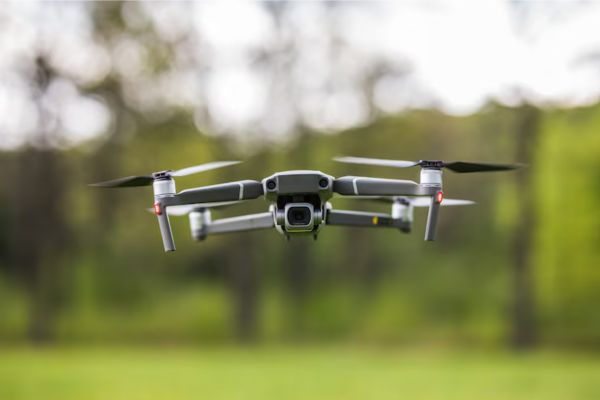In recent years, drones have become an essential part of several industries, including defense, logistics, and agriculture. Communication systems play a crucial role in drones by offering reliable, fast, and secure communication, enabling them to navigate, share data, and operate autonomously with precision. Advances in technologies, such as radio frequency modules, 5G networks, and satellite links, are making drone communication more capable and expanding its commercial use globally. Along with improving operational efficiency, these improvements ensure safety and compliance with evolving regulations across global airspaces.
Drone Communication: Overview
Drone communication encompasses a wide range of technologies that allow drones to transmit data, receive commands, and coordinate with other systems in real-time. These technologies, which include radio frequency links, cellular networks, satellite communications, and mesh networking, are designed to ensure seamless connectivity between the drone, its operators, and other systems. They support various critical functions such as beyond visual line of sight (BVLOS) operations, live video streaming, telemetry, and coordinated swarm flights.
Key Drone Communication Market Stats
- The drone communication market was valued at USD 2,450.61 million in 2024 and is expected to reach USD 5,436.96 million by 2034, according to the latest research report by Polaris Market Research.
- The market is anticipated to exhibit a compound annual growth rate (CAGR) of 8.2% during 2025–2034.
- The report analyzes the radio frequency (RF) communication segment is projected to witness sustained demand in the coming years, as it allows for reliable, real-time data transfer between the drone and its controller.
- The study highlights that North America leads the market for drone communication owing to its significant investments in commercial and military drone applications.
What’s Driving Market Forward?
The drone communication market is being driven by several factors. These include:
Growing Adoption of Drones Across Industries: Drones are being increasingly used in sectors such as defense, agriculture, logistics, infrastructure inspection, and emergency services. This rising adoption is fueling the need for reliable communication systems that allow for autonomous and remote operations. These industries are also looking to improve efficiency and reduce operational costs, further driving demand for advanced communication systems.
Advancements in Communication Technologies: Drone manufacturers are increasingly integrating next-gen networks such as 5G, LTE, and satellite communications. The use of these networks enhances real-time data transmission, low latency, and broader coverage, allowing drones to carry out complex tasks beyond visual line of sight (BVLOS). These technologies also allow for seamless integration with existing telecom infrastructure, accelerating deployment and scalability.
Rising Demand for Autonomous Operations: With drones moving towards fully autonomous missions, robust communication links become essential for real-time control, coordination, and data sharing. This shift requires communication solutions that can support high data throughput and low latency to ensure mission accuracy and safety.
Regulatory Developments and Airspace Integration: Governments and aviation authorities globally are creating frameworks, including mandatory communication standards, to ensure safe drone operations and facilitate broader adoption of commercial UAVs. The mandates are fueling the need for advanced communication technologies.
What Are Major Trends Transforming Market Landscape?
Here’s a look at some of the key trends transforming the drone communication market landscape:
Growth of Mesh Networking and Swarm Communication: The market for drone communication is witnessing an increased shift towards mesh networking and swarm communication. Mesh networking allows multiple drones to communicate directly with each other, enabling coordinated missions like search and rescue, environmental monitoring, and agricultural surveying. Swarm communication helps improve operational efficiency and reliability by distributing data and control commands across the network.
Advancements in Software-Defined Radios (SDRs): Software-defined radios offer drones adaptable communication capabilities that can switch between different frequencies and protocols using the same hardware. SDRs reduce costs and increase interoperability among diverse drone systems. Also, they allow for rapid updates, drone analytics, and customization to meet mission-specific requirements.
Rising Emphasis on Security and Cybersecurity: Drones are being increasingly used for critical applications, making the securing communication of links of utmost importance. There is a rising shift towards advanced encryption techniques, anti-jamming technologies, and secure authentication protocols that help protect drones from hacking, signal interference, and data breaches.
Diverse Applications Across Sectors
Communication systems are at the core of drone operations. They allow drones to execute critical functions across various sectors by ensuring precise control and real-time connectivity. Here’s how drone communication is enabling reliable and efficient drone operations across industries:
Defense & Security: Tactical and military drones rely heavily on highly secure, encrypted links for operations such as surveillance, intelligence gathering, reconnaissance, and strike coordination. These communication systems must guarantee low latency, resistance to hacking, and reliable data transmission in hostile environments.
Agriculture: In precision agriculture, drones use real-time image data and GPS feedback to monitor crops, soil conditions, and irrigation needs. Communication systems support timely decision-making by sending high-resolution images and sensor data to farm management systems instantly.
Logistics & Delivery: The rise of urban air mobility and drone package delivery requires drones to maintain continuous communication with ground stations and traffic management systems. As a result, reliable communication is essential to ensure drones follow accurate routes and avoid collision.
To Conclude
The drone communication market is an essential element of the expanding unmanned aerial vehicles (UAV) ecosystem. As drones evolve from simple remote-controlled devices to fully autonomous systems that can carry out complex missions, the need for advanced drone communication technologies is only expected to grow.

















